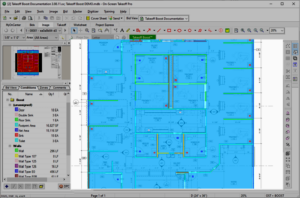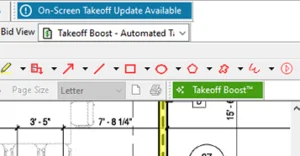Whether your construction business is focused on roofing or concrete, your bidding process may involve lots of moving parts. While you may already be using a digital takeoff tool to eliminate paper blueprints, your estimating workflow may still include a mixed bag of supplier and vendor spreadsheets. Inevitably, this can make bid day a mad scramble—especially if you’re juggling last-minute change orders.
In this case, you wouldn’t want a keystroke error to kill your profit or cause you to lose a potentially profitable project. Even so, it appears many contractors still lean on workflows that include their own processes along with specialized software for bidding and managing projects.
Industry Struggles with Technology
It has been an open secret that the construction industry doesn’t like to invest in technology—whether it involves estimating software or drones for mapping jobsites. For example, many estimators still use colored pencils and blueprints to quantify and create takeoffs.
Even when contractors invest in technology, they are only willing to do so sparingly. For example, the JBKnowledge ConTech Report has repeatedly found survey respondents reporting that they spend less than 1% of revenue on technology.
70% Lack Technology Roadmap
It is interesting to note that the 2020 FMI Industry Report found that 70% of AEC respondents don’t have a technology roadmap. This new study found that contractors are not taking advantage of existing technology that could help their businesses.
For example, while 52% said that maximizing productivity was important, only 40.5% reported using productivity software. Hiring and retaining employees was also cited as critical in the FMI report, but only 25.6% of those respondents said they use technology solutions to help achieve their employment goals.
In addition, many contractors felt they weren’t capable of drawing insights from the data generated by the technology they use. Additionally, 65% said their firms did not have a “stated point of view” about technology.
Integrated Tools Drive Efficiency
For those contractors who do embrace construction technology, the impact can be impressive—especially when they leverage integrated tools. In a ForConstructionPros.com article, PML Construction Inc., a Nebraska commercial drywall contractor, explained why they have used both On-Screen Takeoff (OST) and Quick Bid for estimating for nearly 25 years.
Vice president/project manager Mike McCormack said being able to seamlessly sync the information between OST and Quick Bid has been a game-changer. When changes are made in one tool, the other software automatically updates.
“Having Quick Bid and OST software integrated is very nice because as we build the conditions in On-Screen Takeoff, we are also building the conditions in Quick Bid,” said McCormack. “Also, if we change a condition in OST, we can see the bid total change in Quick Bid. This seamless integration is a big benefit to us.”
As a result, this seamless integration improves accuracy and reduces rework, which can take up to 20% of the cost of the average construction project. OST also improves accuracy by automatically saving takeoff calculations for incoming addendums before bid day, change orders, and revised specs.
Benefits of Integrated Tools
Construction businesses that embrace end-to-end tools realize major gains in speed, accuracy, and efficiency. “When we use Quick Bid, we are able to build detailed conditions that allow us to build accuracy and efficiency into these systems. We also like the reports that are created, and our foremen can use them throughout the course of the project,” McCormack said.
Here are more examples of why contractors should invest in integrated tools:
- Gain a Competitive Advantage – For many contractors, being able to highlight, measure, record, assemble, summarize, price, submit, track, and manage all projects right from their laptops can be a big competitive advantage. Changes during the preconstruction and design phase are also easier to make with integrated tools.
- Improve Bid Accuracy – Starting a new project bid or budget is much easier when you create databases where all material pricing, production rates, and more are stored – rather than searching through spreadsheets. Since much of what contractors do is very repetitive, being able to pull information with the click of a button is a game-changer.
- Track Productivity and Protect Profits – Multiple change orders can turn into a lot of extra work and rework, resulting in cost overruns and turning profits into losses. With integrated tools, you can have a plan to track labor production, hours, and costs so you can correct overages on the spot.
Save Time and Money
Are your current tech tools integrated or mainly siloed, one-off solutions? Transferring data between spreadsheets and keeping up with version control when your tools don’t integrate can be a real stumbling block.
In a highly competitive environment where the low bid gets the job, contractors can lose money before setting foot on a project site. For example, if you’re using software for accounting, project management, and/or estimating, it may be time to consider how much time and money you would save by investing in integrated tools.
Want to learn more about the benefits of an integrated workflow? Go ahead and request a demo now.



